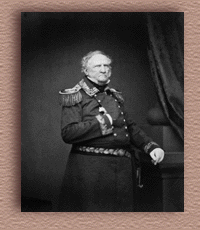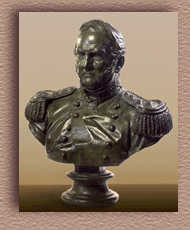


Winfield Scott achieved great early fame as a hero of the War of 1812. Later, in peacetime, he sought to bring professional discipline and training to the army. Throughout the 1830s, he was active in the Indian wars, fighting the Seminole and Creek in Florida and forcing the Cherokee Nation to move west of the Mississippi in 1838. He was also an important negotiator in the 1842 treaty with Britain that established the boundary with Canada. As commander of the United States Army, Scott again led it to victory against Mexico in 1848. To his disappointment, however, Scott's military triumphs never brought political success. In 1852, when he ran for President on the Whig ticket, Franklin Pierce won an overwhelming victory. Following the election, Scott moved his headquarters to New York, where he was a much-admired local celebrity. Scott finally resigned his army post in October 1861, when Lincoln honored him, acknowledging "how faithfully, ably, and brilliantly he has served his country, from a time far back in our history when few of the now living had been born." Scott posed for Mathew Brady many times, and Brady was clearly proud to have the nation's greatest military hero as his patron.
Winfield Scott/Mathew Brady Studio/Imperial salted-paper print, circa 1861
National Portrait Gallery, Smithsonian Institution, Washington, D.C.
Henry Kirke Brown sculpted this bust in 1858, and used it as a model for the equestrian statue of Scott that stands today in the District of Columbia, on Massachusetts Avenue, at the center of Scott Circle. That same year, Brown, Brady, and fourteen other artists of the Washington Art Association issued a call for patriotic art that could "adorn our national Capitol and Capitol grounds." Brown was an especially prolific member of this committee, and many of his statues can be still be found in public squares and parks throughout Washington. One probably apocryphal story says that Brady lost the chance to photograph Fanny Kemble, a famous actress, when he photographed Scott for Brown. According to the story, Kemble stopped by unannounced just when Scott was posing without a shirt, and Brady could not welcome her inside.
Winfield Scott/Henry Kirke Brown (1814-1886)/Bronze, after circa 1858 plaster
National Portrait Gallery, Smithsonian Institution, Washington, D.C.
NEXT photograph
BACK to "Brady and the World of Art"
RETURN to the Table of Contents